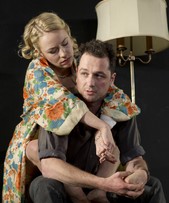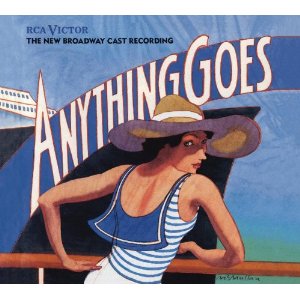SITE GUIDE
SEARCH
REVIEWS
REVIEW ARCHIVES
ADVERTISING AT CURTAINUP
FEATURES
NEWS
Etcetera and
Short Term Listings
LISTINGS
Broadway
Off-Broadway
NYC Restaurants
BOOKS and CDs
OTHER PLACES
Berkshires
London
California
New Jersey
DC
Philadelphia
Elsewhere
QUOTES
TKTS
PLAYWRIGHTS' ALBUMS
LETTERS TO EDITOR
FILM
LINKS
MISCELLANEOUS
Free Updates
Masthead
A CurtainUp Review
Look Back in Anger
By Elyse Sommer
|
God, how I hate Sundays! Itís always so depressing, always the same. We
never seem to get any further, do we? Always the same ritual. Reading the papers,
drinking tea, ironing. A few more hours, and another week gone. Our youth is slipping
away. —Jmmy Porter, for whom the repetitious Sundays symbolize his frustration with everything about the way life has failed to fulfill the promise of new opportunities and open class doors for his post World War 2 generation. |

Sarah Goldberg & Matthew Rhys
(Photo: Joan Marcus) |
Before going any further into director Sam Gold's attempt to make you say yes to all of the above, a bit of background. . .
Back in 1957 John Osborne threw down the theatrical gauntlet to challenge comedies like Noel Coward's Private Lives with its idle rich characters and elegantly furnished sets. In Look Back in Anger's Jimmy and Alison, Osborne created a couple who, like Coward's Eliot and Amanda, were apparently unable to live peaceably with each other, but somehow equally miserable apart. The unhappily undivorced couple's problems were exacerbated by their having been born on opposite ends of the English class structure. And so, the marriage is not just the result of sexual attraction. He wants to prove that he can win her away from her posh background which is made easy by her need to rebel.
A college education failed to move Jimmy out of the impoverished lower class which made his upper class raised wife a handy dart board at which to aim his angry rants. Jimmy and Allison's love/hate relationship played out in tight low-rent quarters where the most dominant prop of the grungy decor was something relegated to the unseen maid's quarters of the then popular plays, an ironing board. Cliff, who lives with them and helps Jimmy run a candy shop is a peace keeping presence. But the arrival of Alison's actress friend Helena sends the complicated marriage into a complete tailspin and paves the way for the surprising new set up for the third act's Sunday of newspaper reading and ironing.
Look Back In Anger was ground breaking enough to open the door to dramas distinguished by what became known as "kitchen sink" realism. Yet Coward's bon mots and the fun of watching gorgeously attired actors on glossy sets have continued to seed Private Lives revivals; to wit the recent production at Broadway's Music Box (review). But even this durable hit may have been done once too often given the enough already reception that led to the recent production's early retirement.
Osborne's most famous play is hardly in danger of being labelled as a too glitzy, light entertainment. And while filmed three times —most famously with Richard Burton, Mary Ury and Claire Bloom — live productions are rare. The Roundabout Theater Company has given its revival of Osborne's insurance against "too dated" complaints by having director Sam Gold give it a new-fangled interpretation.
While Gold has earned his wunderkind stripes with his subtle staging of new plays like Annie Baker's Circle Mirror Transformation and Aliens and Theresa Rebeck's Seminar, his take on Ibsen's *Doll's House at last summer's Williamstown Theater Festival was oddly wrong-headed. Seeing Nora leaving her marriage without the famous door slam leaving the grand slamming finale to the golf club wielding husband left me a bit apprehensive about his re-invention of Osborne.
So how did Gold do? If I were limited to a texting appraisal: Osborne fares better than Ibsen did.
My mini sumup notwithstanding, I could do without the jazz concert that begins the moment the doors to the theater open and continues until the play begins. It's a rather obvious conceit to serve as a setup for the scenes in which Jimmy Porter is seen at the periphery of the main playing area where he's doing his angry rant with his saxophone. Some of the alterations to the text, especially the deletion of an important fifth character, amount to major diddling but in this instance these choices are, if not faithful to the play as written, a means of making the play less tied to the specific point in British history explored by Osborne.
As the movie with Richard Burton took the liberty of expanding the cast along with the play's physical universe, this new production's streamlining goes to the other extreme. I miss the appearance of Alison's father, Colonel Redfern, — the man his daughter called "one of those sturdy old plants left over from the Edwardian Wilderness that can't under-stand why the sun isn't shining anymore." Redfern was a potent counterpoint to Jimmy: The older man's unhappiness being a case of 'everything has changed' while the younger man's unhappiness derived from his sense that 'nothing has changed." Directorial diddling it may be and something to which a living author would object, but relegating the Colonel to a mention in the dialogue does serve to put the more universal and never dated relationship problems front and center.
The most crucial streamlining is Gold's interpretation of Osborne's kitchen sink visual realism. Set designer Andrew Lieberman has been instructed to strip down the Porter's flat to bare bones abstraction — not a single comfortable chair and a sleeping quarters with a chest of drawers and an upright mattress to be pulled as needed . . . a kitchen area is evoked by bags of garbage tossed helter skelter on the floor. As if this wasn't enough to get used to, the set is positioned before a black back wall that cuts off a major portion of the stage so that the action takes place as if in front of a curtain. This also means that the actors enter and exit through emergency exits.
If all this sounds excessively stylized and seems like a waste of the Laura Pels Theater's generous stage, so it is. However, it isn't a completely senseless overhauling of the author's intent that the Doll's House revival in Williamstown was. Even though it doesn't make for an especially appealing stage picture, it does make the point of emphasizing that these people are living in horribly cramped, cluttered quarters. Keeping the actors visible even when not in a scene does, like that narrow, under-utilized setting, underscore the idea that for all the tension in the air, there's very little privacy or getting away from the simmering passions and unpleasant reality of these people's lives.
What ultimately makes this new production more than an overly stylized visual update, is that it does allow Osborne's still powerful dialogue and these complex relationships to come into close-up focus. Fortunately the cast is able to make us respond to their characters' passion and pain, even if we're not smitten with all the directorial gimmickry.
The Welsh-born Matthew Rhys who, according to a recent interview ("Happy to Mine Hidden Charm in Youthful Anger" by Leah Rozen, New York Times, January 19) has wanted to play Jimmy since he watched fellow Welchman, Richard Burtonís movie version as an adolescent. Rhys best known for his work in Brothers and Sisters has not squandered his wish come true. He has the stage magnetis to fill Burton's shoes quite ably, At times he sounds almost eerily like Burton.
Sarah Goldberg, a stunning blonde, brings the required weary misery to the role of Alison, though the interchanges with her father in the original version made for a more nuanced character. Charlotte Parry as Alison's childhood friend is an aptly cool and paradoxical Helena. With Alison's father exiled from the script, it's now up to her to walk Alison out the door instead of contacting the Colonel to come and get her. No matter who plays this role can't hide the authorially contrived elements of this character.
The biggest surprise is Adam Driver as Cliff, the play's least complicated and most sympathetic character. This is not just another instance of the actor being given a chance to perfect his English accent, but Driver's best performance. His relationship with Alison is yet another example of this production's focus on the play's psychological underpinning.
The dialogue still has the power to shoc as in Jimmy's all too prescient cutting comment to his wife: "Youíve got so much to learn. I only hope you learn it one day. If only something--something would happen to you, and wake you out of your beauty sleep! If you could have a child, and it would die. Let it grow, let a recognizable human face emerge from that little mass of india rubber and wrinkles."
While Sam Gold has concentrated on showcasing Osborne's way with dialogue and knotty male-female relationships, the issues fueling Jimmy Porter's tirades, though applying to a different time and place, aren't all that dated these days. The continuing class divide that so infuriated Jimmy's generation of angry young men, is currently very much an issue seeded by the deep and lingering recession. Americans who actually climbed into the middle class of home ownership and social openness have found themselves sliding into insecurity and poverty while the small top percentile of the population has grabbed more and more of their share of the American Dream. Jimmy would be right at home with the Occupy Wall Streeters.
|
Look Back in Anger by John Osborne Directed by Sam Gold Cast: Adam Driver (Cliff), Sarah Goldberg (Alison), Charlotte Parry (Helena), Matthew Rhys (Jimmy) Sets: Andrew Lieberman Costumes: David Zinn Lights: Mark Barton Sound: Bray Poor Fight Director: Thomas Schall Hair Design: Josh Marquette Dialect Coach: Stephen Gabis Stage Manager: Megan Smith Running Time: Approx.2 hours, 20 minutes including one intermission Roundabout at the Laura Pels Theatre in the Harold and Miriam Steinberg Center for Theatre 111 West 46 Street (212)719-13 From 1/13/12; opening 2/02/12; closing 4/08/12 Tickets: $71.00-81.00 Tuesday through Saturday evening at 7:30 p.m. with Wednesday, Saturday and Sunday matinees at 2:00 p.m. Reviewed by Elyse Sommer at January 7th press preview |
|
REVIEW FEEDBACK Highlight one of the responses below and click "copy" or"CTRL+C"
Paste the highlighted text into the subject line (CTRL+ V): Feel free to add detailed comments in the body of the email. . .also the names and emails of any friends to whom you'd like us to forward a copy of this review. Visit Curtainup's Blog Annex For a feed to reviews and features as they are posted add http://curtainupnewlinks.blogspot.com to your reader Curtainup at Facebook . . . Curtainup at Twitter Subscribe to our FREE email updates: E-mail: esommer@curtainup.comesommer@curtainup.com put SUBSCRIBE CURTAINUP EMAIL UPDATE in the subject line and your full name and email address in the body of the message. If you can spare a minute, tell us how you came to CurtainUp and from what part of the country. |
 Anything Goes Cast Recording
Anything Goes Cast RecordingOur review of the show
 Book of Mormon -CD
Book of Mormon -CDOur review of the show

Slings & Arrows-the complete set
You don't have to be a Shakespeare aficionado to love all 21 episodes of this hilarious and moving Canadian TV series about a fictional Shakespeare Company

